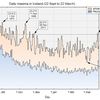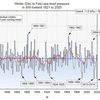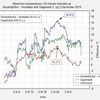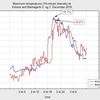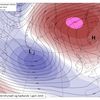Bloggfćrslur mánađarins, desember 2015
31.12.2015 | 15:19
An unusually low pressure recorded in Iceland
During the night and morning of 30 December 2015 an unusually deep low crossed Iceland. The minimum officially recorded sea level pressure was 930.2 hPa, measured at the station Kirkjubćjarklaustur in the Southeast at 5am. This is the lowest sea level reading in Iceland since 24 December 1989 when the pressure at Stórhöfđi in the islands of Vestmannaeyjar measured 929.5 hPa. On 5 January 1983 the pressure at Stórhöfđi was down to 929.9 hPa.
During the morning hours the low crossed the country from the south to the north. The map below shows the situation at 9 am.
The lowest reading in the North was at Akureyri at 8 am, 932.0 hPa, the second lowest ever recorded there, exceeded only by the 931.4 hPa measured on 3 January 1933. At that occation the lowest pressure in the country was 923.9 hPa (Vestamannaeyjar).
The lowest pressure ever recorded in Iceland is 919.7 hPa, measured at Vestmannaeyjar 2 December 1929. However, the reading was made during strong winds, Bf 11. This throws some doubt on the exact value of the pressure, but it was certainly lower than the 1933 reading (when the wind was not a problem).
There is also a measurement of 929.0 hPa made at Vestmannaeyjar on 27 December 1914.
There are two (or three) measurements of below 930 hPa pressure in Iceland during the 19th century. Two are considered quite sound, but the exact hPa values can be debated. The third one was made, but later retracted by the observer after an inquiery, however, there are some doubts remaining, because of wind damages that occurred on the same day.
As seen on the map above the wind was strongest on the eastern side of the low pressure centre. Hurricane force winds (10-min sustained >32.7 m/s) were recorded on 7 stations, the maximum being, 43.9 m/s at the mountainpass Vatnsskarđ in the east, the highest sustained value at a coastal station was 38.6 m/s, at Papey. A gust of 63.8 m/s was recorded at the station Steinar in the south, but has not been ratified at the time of writing.
There was considerable local wind damage in the east, but the main damage was caused by an unusually high sea level inside the eastern fjords where a few seaside houses are probably beond repair. No human injuries were sustained by the weather.
This was the second great storm to hit Iceland this Deceember. The first one [on 7 and 8 December] was worse in terms of wind and damage, affecting more than 2/3 of the country, blowing cars of roads and destroying houses. Hurricane force winds (sustained) were then measured on 33 stations (compared to 7 now, as mentioned above), the maximum being 50.9 m/s.
Bloggar | Slóđ | Facebook | Athugasemdir (0)
Um bloggiđ
Iceland Weather blog
Nýjustu fćrslur
- Unusually high temperatures
- Unusually high sea level pressure
- Sea level pressure: Unusually low in Iceland this winter
- A new national maximum temperature record for December
- A new sea level pressure record for June in Iceland
- An unusually warm April in Iceland
- A new October high pressure record in Iceland
- A new absolute September maximum temperature record in Iceland
Heimsóknir
Flettingar
- Í dag (19.4.): 1
- Sl. sólarhring: 5
- Sl. viku: 16
- Frá upphafi: 10254
Annađ
- Innlit í dag: 1
- Innlit sl. viku: 16
- Gestir í dag: 1
- IP-tölur í dag: 1
Uppfćrt á 3 mín. fresti.
Skýringar
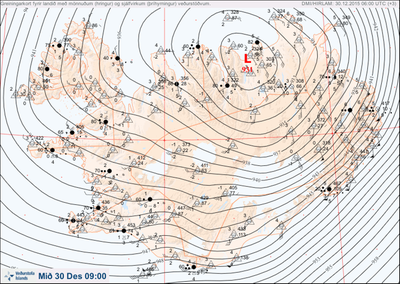


 hoskibui
hoskibui
 svatli
svatli
